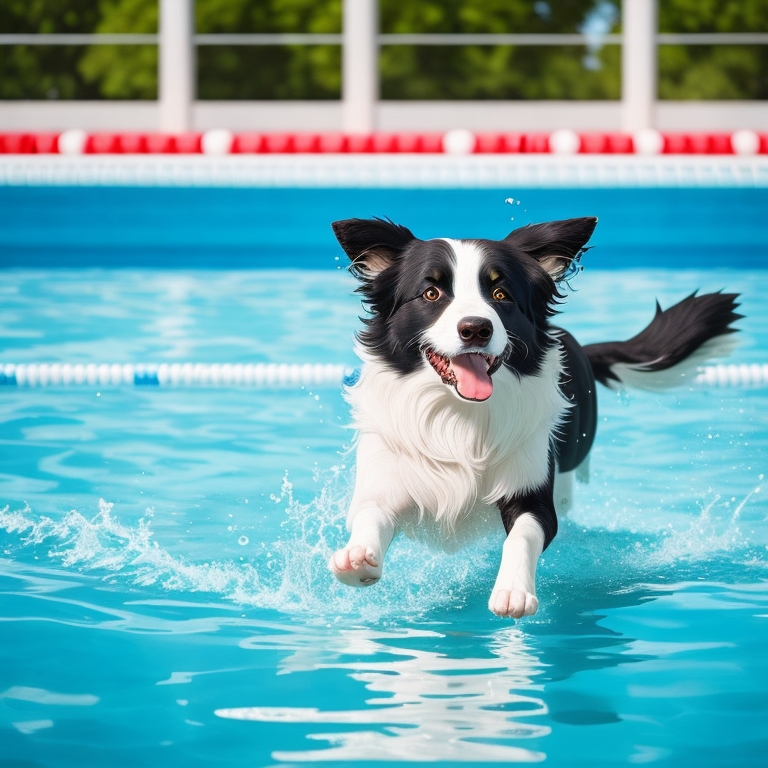How To Prevent Border Collies From Herding Children Or Other Pets?
Do you have a Border Collie that insists on herding your children or other pets? It can be frustrating and even dangerous if left unchecked.
But before you get angry and give up on your furry friend, it’s important to understand their natural instincts.
Border Collies were bred for herding, and it’s in their DNA to chase and corral other animals. In this article, we’ll explore where this behavior comes from, how to prevent it, and how to manage it safely.
With the right approach, you can help your Border Collie live happily in your home without causing chaos.
| Prevention Tips | Description |
|---|---|
| Teach commands | Teach your Border Collie basic obedience commands like “sit” and “stay” to help them exercise control around children or other pets |
| Provide socialization | Expose your Border Collie to children and other pets early on so they learn to interact in a calm manner |
| Provide plenty of exercise | A well-exercised Border Collie is less likely to display herding behaviors towards children or other pets |
| Use positive reinforcement | Use positive reinforcement methods like treats and praise when your Border Collie behaves appropriately around children or other pets |
| Supervise interactions | Always monitor interactions between your Border Collie and children or other pets to ensure safety |
| Consider seeking professional help | If your Border Collie continues to display herding behaviors towards children or other pets, consider consulting with a professional dog trainer |
Understanding Border Collies’ herding instincts
Origins of the Breed
Border Collies are a breed of herding dog that originated in the border regions of Scotland and England. They were originally bred by farmers who needed a dog that could help them manage their livestock, particularly sheep.
The breed is known for its keen intelligence, intense focus, and unparalleled work ethic, which makes them one of the best herding dogs in the world.
The Border Collie’s herding instincts are deeply ingrained and developed over generations of selective breeding. As a result, they have an innate drive to control and manage other animals, which can sometimes extend to children or other pets.
Understanding the breed’s origins is essential to managing their herding instincts effectively.

Instincts and behavior pattern
Border Collies are known for their natural herding instincts, which can make them great working dogs but challenging pets. These instincts are deeply ingrained in their behavior patterns and can cause Border Collies to display herding behaviors with children and other pets.
One of the reasons why Border Collies are prone to herding behavior is their history as working dogs on farms.
They were bred for their ability to round up and move livestock, which means they inherently possess certain characteristics such as high energy, intelligence, and a strong work ethic. These traits can lead Border Collies to try and herd anything that moves, including children and other pets.
Their herding instinct can manifest as chasing, nipping, and circling behavior that can be dangerous for young children and smaller pets.
It’s essential for Border Collie owners to understand their dog’s natural instincts and behavior patterns so that they can take the necessary steps to prevent potential harm. By recognizing their herding tendencies and addressing them with appropriate training and management strategies, Border Collies and their families can live harmoniously together.

Techniques for helping Border Collies overcome their herding behavior
Physical exercise and Mental Stimulation
Physical exercise and mental stimulation are two powerful tools for helping Border Collies overcome their herding behavior. These techniques help to tire the dog out and redirect their energy towards more appropriate forms of behavior.
Physical exercise can take many forms, including walks, runs, and hikes.
Border Collies have high energy levels and require frequent exercise to stay healthy both physically and mentally. They enjoy having a job to do, such as playing fetch or learning new tricks.
These activities also give them an outlet for their intense herding instincts.
Mental stimulation is just as important as physical exercise in preventing herding behavior. Border Collies are highly intelligent dogs that thrive on mental challenges.
Puzzle toys, interactive games, and training exercises all provide the mental stimulation they need to prevent boredom and destructive behavior.
Together, physical exercise and mental stimulation are powerful tools in helping Border Collies overcome their herding behavior. By providing outlets for their energy and intelligence, you can redirect their instincts towards appropriate behavior and enjoy a happy, well-trained dog.
Obedience and Training
Obedience and training are essential techniques to help Border Collies overcome their herding behavior. As a Border Collie owner, it’s crucial to train them early on to learn obedience commands.
Simple commands such as sit, stay, come, and down can be of great help in managing their behavior.
Training your Border Collie with positive reinforcement, such as treats, rewards, and praise, is the most effective strategy. Border Collies are intelligent and enjoy learning new commands, making training sessions exciting for them.
Patience and consistency are critical; you need to keep the training sessions short, regular, and fun.
Professional training classes are also beneficial, providing you with the tools and guidance you need to train your Border Collie. A professional dog trainer understands your dog’s behavior and how to train them according to their unique needs.
Suppose your Border Collie shows herding behavior towards other pets or children.
In that case, you can use obedience training to teach them commands such as “leave it” or “stay.” These commands can be a great help in preventing your Border Collie from herding other pets or children. Obedience and training are crucial techniques to help your Border Collie overcome their herding instincts.
Training through positive reinforcement is the most effective strategy, and consistency is key.
Professional training classes can also be a great help. Remember, it’s never too late to start training your Border Collie, and with patience and dedication, you can successfully manage their herding behavior.

Direct Intervention and Negative Reinforcement
Direct Intervention and Negative Reinforcement: Direct intervention and negative reinforcement are both useful techniques for Border Collies with herding issues. Direct intervention involves physically stopping the dog from heading or nipping at others.
It can be useful when the dog’s behavior is dangerous or uncontrollable.
Negative reinforcement includes a correction when the dog is displaying herding behavior, such as a firm “no” or a clap. The dog then learns that displaying herding behavior results in a negative consequence.
It is essential to ensure that negative reinforcement is immediate and consistent as timing and consistency are crucial factors for effectively discouraging problematic behavior.
However, it is important to remember that harsh or excessive negative reinforcement methods may cause further behavior issues and worsen the situation. Positive reinforcement techniques should always be the priority for correcting herding behavior in Border Collies.

Successful Strategies for managing Border Collies’ behavior
Effective Communication
Effective communication is crucial in managing the behavior of Border Collies. As dogs are unable to understand human language, it is important to use body language and consistent verbal cues.
When teaching your Border Collie, use short and specific commands that you consistently use throughout training.
For example, use the word “sit” instead of saying “sit down” or “please sit”. Use visual cues such as hand signals and body posture to reinforce your command.
Reinforce positive actions such as appropriate behavior around children or other pets with praise and treats.
This type of positive reinforcement will help your Border Collie understand what is expected of them and encourage them to repeat these behaviors. It is important to always stay calm and avoid yelling or using negative reinforcement, as this can create a sense of fear and confusion in your Border Collie.
Remember to remain consistent in your communication and actions to create a sense of stability for your pet.
In summary, effective communication involves using consistent verbal and non-verbal cues to reinforce positive behavior in your Border Collie. By building a positive relationship with your pet, you can help them overcome their herding behavior and live a happy, healthy life within your family.

Clear Family Rules
Clear family rules are an essential component in managing Border Collies’ behavior. These rules should be established and followed consistently by all family members.
Rules such as not allowing the dog to be possessive of toys or food, not allowing it on the furniture unless invited, and not chasing or herding people or other pets in the household should be enforced.
When setting these rules, it’s important to communicate them clearly to the dog in a positive and consistent manner. Positive reinforcement techniques such as rewards and praise for good behavior can help reinforce these rules.
It’s also important to provide consistency in enforcing these rules to prevent confusion and to help the dog learn.
Consistently following clear family rules helps Border Collies understand their position in the family hierarchy and reinforces their training. It also helps create a stable and predictable environment for the dog, reducing their stress levels and minimizing negative behavior.
In summary, clear family rules are a critical tool in managing Border Collies’ behavior.
Establishing and enforcing clear and consistent rules helps prevent herding behavior and creates a peaceful and predictable household that is the key to a happy and healthy relationship between a Border Collie and its human family.

Supervision and Separation Strategies
Supervision and Separation Strategies are essential when it comes to preventing Border Collies from herding children or other pets. Here are some straightforward strategies you can adopt to keep your Collie’s herding behavior in check:
- Supervise Collies closely when they are around children or other vulnerable animals. This will help you detect any herding attempts early on and correct the behavior if necessary.
- Separate your Collie from situations where they might feel the urge to herd. For example, keep your Collie in a separate room or in a crate when children are playing.
- Make sure all family members understand the importance of supervision and separation. Teach them how to recognize and respond to herding behavior to prevent accidents.
By adopting these supervision and separation strategies, you can keep your Border Collie’s herding instincts under control and create a harmonious environment for all family members and pets.

Conclusion
Border Collies have a natural herding instinct that can be directed towards children or other pets in the household, which can be challenging for pet owners. Understanding the breed’s origins, instincts, and behavior patterns can help us develop targeted strategies for managing their behavior.
Effective communication, clear family rules, and supervision and separation strategies are essential elements in managing this breed’s behavior.
Additionally, physical exercise, mental stimulation, obedience and training, and direct intervention can help prevent Border Collies from herding children or other house pets. By keeping a watchful eye on our pets and providing them with the appropriate outlets for their instincts, we can live harmoniously and safely with our furry friends.
With the right approach and diligent attention, we can help our Border Collies overcome their natural instincts and become cherished members of the family.







